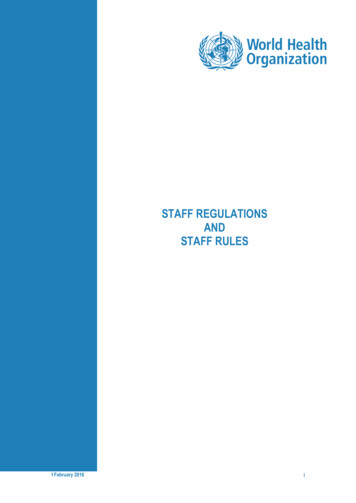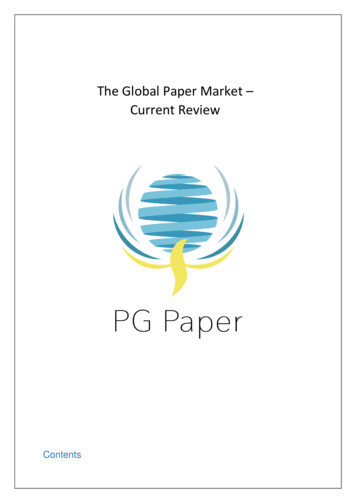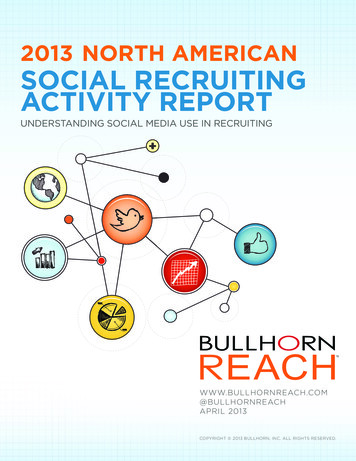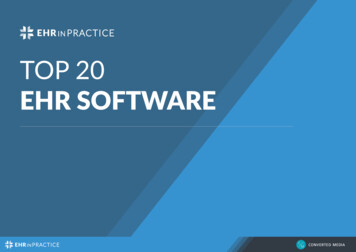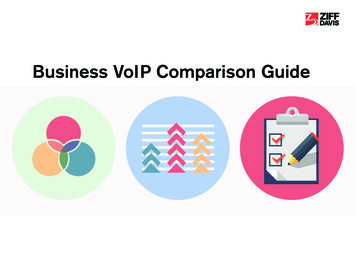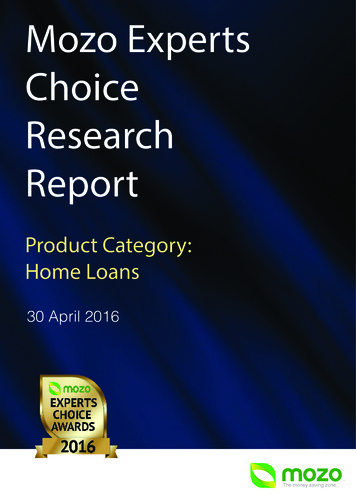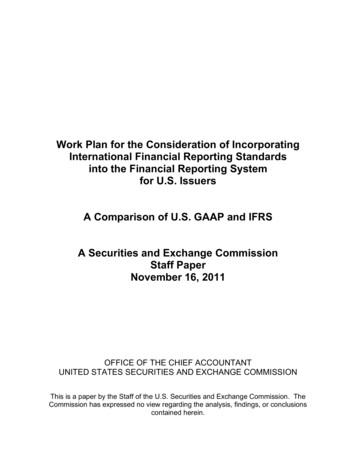
Transcription
Work Plan for the Consideration of IncorporatingInternational Financial Reporting Standardsinto the Financial Reporting Systemfor U.S. IssuersA Comparison of U.S. GAAP and IFRSA Securities and Exchange CommissionStaff PaperNovember 16, 2011OFFICE OF THE CHIEF ACCOUNTANTUNITED STATES SECURITIES AND EXCHANGE COMMISSIONThis is a paper by the Staff of the U.S. Securities and Exchange Commission. TheCommission has expressed no view regarding the analysis, findings, or conclusionscontained herein.
TABLE OF CONTENTSI.II.III.Introduction.1Methodology .2A.Scope of the Analysis.2B.MoU and Other Joint Projects.3C.SEC Rules and Regulations .8D.General Observations and Clarifications .8Comparison of Requirements .11A.Accounting Changes and Error Corrections .11B.Earnings Per Share.13C.Interim Reporting .14D.Risks and Uncertainties.15E.Segment Reporting.16F.Cash and Cash Equivalents.17G.Other Investments .18H.Inventory .20I.Other Assets and Deferred Costs .21J.Intangibles.22K.Property, Plant, and Equipment .24L.Liabilities .26M.Asset Retirement and Environmental Obligations .26N.Exit or Disposal Cost Obligations.28O.Commitments pensation – Excluding Share-based Payments .34T.Stock Compensation .37U.Other Expenses .39V.Research and Development.41W.Income Taxes .42X.Business Combinations.44Y.Foreign Currency Matters and Inflation .45Z.Nonmonetary Transactions .47AA. Related Party Disclosures .48BB. Reorganizations.49CC. Subsequent Events .49
I.IntroductionIn the Commission Statement in Support of Convergence and Global Accounting Standards,1 theU.S. Securities and Exchange Commission (“SEC” or “Commission”) directed the staff of theOffice of the Chief Accountant of the SEC, with consultation with other Divisions and Offices ofthe Commission (collectively, “Staff” or “we”), to develop and execute a work plan (“WorkPlan”).2 The Work Plan was published in February 2010. The purpose of the Work Plan is toconsider specific areas and factors relevant to a Commission determination as to whether, when,and how the current financial reporting system for U.S. issuers should be transitioned to a systemincorporating International Financial Reporting Standards (“IFRS”).3The Work Plan is divided into six areas of focus. The first area involves an assessment ofwhether there is “sufficient development and application of IFRS for the U.S. domestic reportingsystem.” This area was designed to respond to Commission statements that, in furtherconsidering IFRS, it would need to “consider whether those accounting standards are of highquality and sufficiently comprehensive”4 and that “[a] necessary element for a set of globalaccounting standards is that they must be high-quality .”5 The Commission has describedhigh-quality standards as requiring “consistent, comparable, relevant and reliable information thatis useful for investors, lenders and creditors, and others who make capital allocation decisions.”6In the Work Plan, the Staff noted that its evaluation of the sufficient development and applicationof IFRS would include inventorying areas in which IFRS does not provide guidance or where itprovides less guidance than U.S. GAAP. The manner in which the Staff intended to perform theinventory was further explained in the Staff’s October 2010 Progress Report7 as an analysis of thetext of IFRS as issued by the IASB as compared to the text of U.S. GAAP. In this paper, theStaff summarizes the results of its analysis.1See SEC Release No. 33-9109 (Feb. 24, 2010), Commission Statement in Support of Convergence and GlobalAccounting Standards (“2010 Statement”).2The Work Plan is included as an appendix to the 2010 Statement.3As used in this Staff Paper, the term “IFRS” refers to “IFRS as issued by the International Accounting StandardsBoard (‘IASB’),” unless otherwise noted. Further, the term “IFRS” refers to the authoritative text of IFRS, which,according to the IFRS Foundation Constitution, is published in English. See “International Financial ReportingStandards (IFRSs) as issued at 1 January 2010, Preface to International Financial Reporting Standards.” The “IASB”is the International Accounting Standards Board. “IFRSs” refers to more than one International Financial ReportingStandard.4See SEC Release No. 33-8982 (Nov. 14, 2008) [73 FR 70816 (Nov. 21, 2008)], Roadmap for the Potential Use ofFinancial Statements Prepared in Accordance with International Financial Reporting Standards by U.S. Issuers.52010 Statement.6See SEC Release No. 33-7801 (Feb. 16, 2000) [65 FR 8896 (Feb. 23, 2000)], International Accounting Standards(“2000 Concept Release”).7See U.S. Securities and Exchange Commission, Office of the Chief Accountant and Division of CorporationFinance, Work Plan for the Consideration of Incorporating International Financial Reporting Standards into theFinancial Reporting System for U.S. Issuers, Progress Report (October 29, 2010).1
II.MethodologyThe Staff used a comparative approach to provide a context in which to frame its evaluation ofIFRS, rather than to establish a minimum threshold of development that must be met for theincorporation of IFRS into the financial reporting system for U.S. issuers. The Staff used U.S.GAAP specifically as its reference point because: (1) it is the body of standards that currentlyapplies to U.S. issuers and from which investors would be required to adjust their analyses ofU.S. issuers’ financial statements, and (2) it enables the Staff to minimize its consideration ofareas in which IFRS currently has the same or similar accounting requirements as U.S. GAAP, asthose IFRS requirements are presumably of sufficiently high quality.8 As a result, our review wasfocused on identifying areas in which the requirements of IFRS and U.S. GAAP differ. Thisreview did not include an analysis of the impact that those differences, individually orcollectively, may have on the quality of IFRS.A. Scope of the AnalysisThe Staff reviewed U.S. GAAP accounting requirements and compared those requirements toequivalent or corresponding IFRS requirements, as applicable. The Staff omitted from its reviewany U.S. GAAP requirements and the IFRS equivalents that are subject to the ongoing jointstandard-setting efforts either through the Memorandum of Understanding (“MoU”) jointstandard-setting projects (“Joint Projects”) of the FASB and the IASB (together with the FASB,the “Boards”) or other efforts by the Boards to work together, as further explained below. 9Having excluded the areas of U.S. GAAP and IFRS subject to the ongoing Joint Projects, weanalyzed the remaining U.S. GAAP Accounting Standards Codification (“ASC”) Topics and theircorresponding or equivalent IFRS requirements.This paper summarizes our observations at a principles level for each ASC Topic that weevaluated. We then supplement those high-level observations with more specific examples ofdifferences between U.S. GAAP and IFRS. The differences discussed do not comprise acomprehensive population of differences. We endeavored to provide examples that we believecould have a more significant or widespread financial reporting impact. However, we are awarethat differences between IFRS and U.S. GAAP will affect individual preparers and investors todifferent extents.8The Staff believes U.S. GAAP is a set of high-quality standards because the SEC currently recognizes the financialaccounting and reporting standards of the Financial Accounting Standards Board (“FASB”) as generally accepted forpurposes of the federal securities laws under Section 19(b) of the Securities Act. See SEC Release No. 33-8221(April 25, 2003), Policy Statement: Reaffirming the Status of the FASB as a Designated Private-Sector StandardSetter.9The Boards are working on (or have finalized, as noted) joint standard-setting projects related to financialinstruments, revenue recognition, leases, presentation of other comprehensive income, fair value measurement(finalized in 2011), balance sheet netting of derivative and other financial instruments, financial instruments withcharacteristics of equity, financial statement presentation, presentation of discontinued operations, consolidation ofvoting interest entities, derecognition (finalized in 2010), and insurance contracts. Some of these projects arepursuant to the MoU (entered into in 2006 and subsequently updated in 2008) that sets forth the scope of the Boards’joint work program to improve and promote convergence of their accounting standards.2
The ASC Topics and IFRSs within the scope of our analysis generally are those that werefinalized and incorporated into the respective bodies of authoritative accounting guidance at thetime of the analysis (generally, U.S. GAAP standards finalized by June 30, 2010 and IFRSsfinalized by January 1, 2010). Appreciating that the Boards have continued to finalize newstandards or amend existing standards since our analysis began, we have updated the sections inthis paper for which the revised guidance had a more significant effect (either decreasing orincreasing differences between the two sets of standards) on our comparison between U.S. GAAPand IFRS. For example, section III.G. Other Investments is updated to reflect the IASB’sissuance of IFRS 11, Joint Arrangements, and IFRS 12, Disclosure of Interests in Other Entities,and section III.S. Compensation – Excluding Share-based Payments is updated to reflect theIASB’s amendments to IAS 19, Employee Benefits.B. MoU and Other Joint ProjectsThe FASB and IASB jointly issued the MoU in 2006 (updated in 2008) and, in that document,identified the standard-setting projects that the Boards considered to be most in need ofimprovement in the near-term. The Boards agreed to develop a plan to address each of theidentified projects, primarily through the development of new standards in an effort to improvethe quality of both sets of standards and achieve greater convergence between U.S. GAAP andIFRS. The MoU included short-term projects, some of which have been completed or are close tocompletion, and longer-term projects. The results of the short-term projects, in terms of thegeneral similarities between U.S. GAAP and IFRS, both as amended by the projects, and anysignificant differences not resolved by the Boards, are reflected in this paper in the relevant partsof section III. Of the longer-term projects, three are of a greater priority—financial instruments,revenue recognition and leasing—for which the Boards have yet to finalize the technicaldecisions. The following table provides a listing of the longer-term projects, the current status ofeach project, related milestones, and the extent of inclusion of the project in this paper.3
ProjectStatusMilestoneFinancialinstrumentsVarious for thedifferent projectelements.The financial instruments project includes the following elements:classification and measurement, impairment, hedge accounting, andbalance sheet offsetting. Although the Boards continue to have theobjective of issuing converged standards, project timing and the phasingof the project has differed for each Board. A summary of each Board’sactivities is as follows:The IASB considers each element (listed above) as a separate phase.Accordingly, the Board issued IFRS 9, Financial Instruments, inNovember 2009, which contained requirements for financial assets.Requirements for financial liabilities were added to IFRS 9 in October2010. IFRS 9 is not yet effective, but early adoption is permitted. TheIASB (together with the FASB) issued a supplementary document,Financial Instruments: Impairment, in January 2011. The commentperiod closed in April 2011 and redeliberations are on-going. The IASBissued the exposure draft, Hedge Accounting, in December 2010. Thecomment period closed in March 2011 and redeliberations are on-going.The FASB initially scoped the financial instruments project as twophases—1) classification and measurement, impairment, and hedging and2) balance sheet offsetting. In May 2010, the Board issued a proposedAccounting Standards Update (“ASU”), Accounting for FinancialInstruments and Revisions to the Accounting for Derivative Instrumentsand Hedging Activities. The comment period ended in September 2010.In January 2011, the FASB (together with the IASB) proposed a commonsolution for impairment accounting, Supplementary Document—Accounting for Financial Instruments and Revisions to the Accountingfor Derivative Instruments and Hedging Activities—Impairment. Thecomment period ended in April 2011. In February 2011, the FASBissued a Discussion Paper—Invitation to Comment—Selected Issuesabout Hedge Accounting, to solicit input on the IASB’s exposure draft inorder to improve, simplify, and converge the financial reportingrequirements for hedging activities. The comment period ended in April2011. Redeliberations are ongoing for all aspects of this project.The balance sheet offsetting portion of the project has followed aconsistent timeline for both Boards. In January 2011, the Boards jointlyissued the exposure draft, Balance Sheet Offsetting (titled by the IASBas, Offsetting Financial Assets and Financial Liabilities), whichproposed changes to address the differences between IFRS and U.S.GAAP. In June 2011, in the light of feedback received on the exposuredraft, the Boards decided to move forward with different offsettingmodels. The Boards noted that users consistently asked that informationbe provided to help reconcile differences in the offsetting requirementsbetween IFRS and U.S. GAAP. Therefore, the Boards decided to workon converging disclosure requirements to assist users in comparingfinancial statements prepared in accordance with IFRSs and US GAAP.Such deliberations are ongoing.Note: Because this project was an active on-going MoU project at thetime of our analysis, a comparison of the existing FASB and IASBstandards related to this project has been excluded from this paper.4
e ofproposals.The Boards published a joint discussion paper, Preliminary Views onRevenue Recognition in Contracts with Customers, in December 2008and a joint exposure draft, Revenue from Contracts with Customers, inJune 2010. In June 2011, the Boards concluded that, although their dueprocess requirements made it clear that re-exposure was not required,they would re-expose the proposals because of the special nature ofrevenue.Note: Because this project was an active on-going MoU project at thetime of our analysis, a comparison of the existing FASB and IASBstandards related to this project has been excluded from this paper.LeasesRedeliberation ofexposure draft; reexposure of proposals.The Boards published a joint discussion paper, Leases: PreliminaryViews, in March 2009 and a joint exposure draft, Leases, in August2010. In July 2011, the Boards agreed to re-expose the revised proposalsbecause the decisions taken to date were sufficiently different from thosepublished in the exposure draft to warrant re-exposure. The Boardsexpect to continue re-deliberations through 2011.Note: Because this project was an active on-going MoU project at thetime of our analysis, a comparison of the existing FASB and IASBstandards related to this project has been excluded from this paper.ConsolidationsOngoing (re:investmentcompanies).The IASB issued IFRS 10, Consolidated Financial Statements, and IFRS12, Disclosure of Interests in Other Entities, in May 2011. IFRS 12includes disclosure requirements about off balance sheet risks. Theissuance of IFRS 10 resulted in substantial convergence of IFRS withU.S. GAAP on consolidation of structured investment vehicles and otherspecial purpose entities as well as related disclosures, althoughdifferences between IFRS 10 and ASC Topic 810, Consolidation,remain. The Boards continue to jointly consider issues related to theconsolidation of investment companies and plan to issue convergedstandards in the future.Note: Because this project was an active on-going MoU project at thetime of our analysis, a comparison of the existing FASB and IASBstandards related to this project has been excluded from this paper.Fair valuemeasurementCompleted.The FASB issued FASB Statement No. 157, Fair Value Measurements,(codified in ASC Topic 820, Fair Value Measurements and Disclosures)in 2006. The FASB has issued several ASUs in 2009-2011 (includingthe most recent amendment: ASU No. 2011-04, Amendments to AchieveCommon Fair Value Measurement and Disclosure Requirements in U.S.GAAP and IFRSs, that was released to coincide with the IASB’s issuanceof IFRS 13, Fair Value Measurement). The IASB issued IFRS 13 inMay 2011. The recent guidance issued by the Boards is converged.Note: Because this project was an active on-going MoU project at thetime of our analysis, a comparison of the existing FASB and IASBstandards related to this project has been excluded from this paper.5
onReassessed as a lowerpriority project.The Boards published a joint discussion paper, Preliminary Views onFinancial Statement Presentation, in October 2008. After consideringthe 220 comment letters and the results of field tests, the FASB andIASB staff published staff drafts reflecting the Boards’ tentativedecisions to date. The Boards used that draft as the basis for additionaloutreach.The outreach indicated that some participants had concerns about aspectsof the proposals but supported others. The Boards concluded thatsignificant additional work would be required to develop a viableexposure draft. In the light of other priorities, the Boards decided toconsider returning to the project once the other MoU projects had beencompleted.The Boards did, however, decide to align how other comprehensiveincome is reported. The Boards published an exposure draft, Statementof Comprehensive Income, in May 2010 and issued amendments in June2011.Note: This project remains on the FASB/IASB technical plan; however,the project was reassessed as a lower priority project. The standardsrelated to this project have been excluded from this paper.DerecognitionProject scopereassessed.Through separate standard setting efforts completed by the end of 2010,the Boards reduced differences between IFRS and U.S. GAAP relating tothe derecognition of financial assets and liabilities and substantiallyaligned the related disclosure requirements.Note: Because this project was an active on-going MoU project at thetime of our analysis, a comparison of the existing FASB and IASBstandards related to this project has been excluded from this paper.PostemploymentbenefitsCompleted.In April 2010, the IASB published an exposure draft, Defined BenefitPlans. The IASB finalized amendments to IAS 19, Employee Benefits, inJune 2011.Note: The changes resulting from the amendments to IAS 19 have beenincorporated into our analysis and included in this paper (see sectionsIII.N. Exit or Disposal Cost Obligations and III.S. Compensation –Excluding Share-based Payments).BusinesscombinationsCompleted.The Boards issued joint requirements for business combinationaccounting and noncontrolling interests in 2008—IFRS 3, BusinessCombinations, and amended IAS 27, Consolidated and SeparateFinancial Statements, and FASB Statement No. 141 (revised), BusinessCombinations, codified in ASC Topic 805.Note: Because this project was finalized before our comparison analysiswas performed, a comparison of the FASB and IASB standards related tothis project has been included in this paper (see section III.X. BusinessCombinations).6
acteristicsof equityReassessed as a lowerpriority project.In February 2008, the IASB published a discussion paper, FinancialInstruments with Characteristics of Equity, to solicit input on apreviously exposed FASB document. The IASB and FASB used theresponses to help them develop a working draft of a proposal to replaceexisting guidance on these types of financial instruments, which theyused to undertake focused outreach. In the light of comments received,the Boards decided to focus on other projects and not to publish anexposure draft in the near term as originally planned. The Boards willconsider returning to this project at a later date.Note: This project remains on the FASB/IASB technical plan; however,the project was reassessed as a lower priority project. The standardsrelated to this project have been excluded from this paper.IntangibleassetsReassessed as a lowerpriority project.The IASB considered an agenda proposal to add a project on intangibleassets in December 2007. The IASB decided not to proceed with theproject but will reconsider it when it sets its new agenda. The FASB hasnot added a project to its active agenda.Note: Because this project was not an active on-going MoU project atthe time of our analysis, a comparison of the existing FASB and IASBstandards related to this project has been included in this paper (seesection III.J. Intangibles).InsuranceRedeliberation ofexposure draft; reexposure of proposals.The IASB published an exposure draft, Insurance Contracts, on July 30,2010. The FASB published a discussion document of its own, whichincluded alternative views, in September 2010. Most recently, theBoards have been considering together the feedback received on theIASB’s exposure draft and the FASB discussion paper. The Boards areconducting targeted outreach, based on the decisions made, to a broadrange of global constituents and will continue to do so on futuredecisions. The IASB is working to issue a review draft or revised ED byin the 1st half of 2012. The FASB will consider the feedback received onits exposure draft with a view to finalizing a standard in 2012. TheBoards will then consider any differences that may have arisen and howbest to address them.Note: Because this project was an active on-going joint project at thetime of our analysis, a comparison of the existing FASB and IASBstandards related to this project has been excluded from this paper.We are assessing the ongoing Joint Projects separate from the comparison analysis that is thesubject of this paper. Our assessment of the Joint Projects includes monitoring the Boards’deliberations, reviewing exposure documents, and considering constituent comment letters,among other activities. The status of the Joint Projects and conclusions reached therein arefactors, among many others, for the Commission to evaluate in its consideration of whether toincorporate IFRS into the financial reporting system for U.S. issuers.To date, the Boards have reached substantially (if not fully) converged positions on certain of theongoing projects (revenue recognition and leases), thereby increasing the probability that IFRS7
and U.S. GAAP will be converged in these areas in the near-term. However, based on thedeliberations and tentative conclusions reached thus far, it is unclear whether the Boards will beable to reach convergence on key aspects of all projects (e.g., on the various elements of thefinancial instruments project). Further, the Boards’ reprioritization of certain Joint Projects (e.g.,financial instruments with characteristics of equity) makes it unclear whether these projectswould be completed in the foreseeable future and, if so, whether substantive progress towardsconvergence would be made before any Commission consideration of whether to incorporateIFRS into the financial reporting system for U.S. issuers. The Commission indicated in the 2010Statement that development of high-quality standards through the Joint Projects is important, andsuch development is an area of focus for the Staff, regardless of any ultimate determination ofwhether to incorporate IFRS into the financial reporting system for U.S. issuers.C. SEC Rules and RegulationsThe scope of our analysis generally did not consider SEC rules and regulations or Staff guidance,other than in the limited instances noted in the paper. The purpose of this paper is tocommunicate a summary of the results of our evaluation of the similarities and differencesbetween U.S. GAAP as recognized by the FASB and IFRS as issued by the IASB, without regardto additional requirements or interpretations provided by jurisdictionally-authoritative bodies,including securities regulators. National laws and regulations affect the application of IFRSacross jurisdictions and, therefore, can affect the consistent application of IFRS across companies,industries, and countries. The 2010 Statement and the Work Plan both indicate the importance ofconsidering the application of IFRS and the consistency of its application globally; however,consistency of application is a separate analysis from that which was conducted in connectionwith the preparation of this paper. Furthermore, SEC rules and regulations and Staff guidancewould need to be evaluated separately to determine whether any recommendation would beappropriate to modify them as a result of any Commission decision to incorporate IFRS into theU.S. financial reporting system.D. General Observations and ClarificationsIn this paper, we discuss some of the detailed differences we noted in comparing the text of U.S.GAAP to that of IFRS. As described further below, we generally noted that U.S. GAAP containsmore detailed, specific requirements than IFRS. In some instances, IFRS does not contain anycorresponding guidance and, in others, IFRS contains higher-level or general guidance that is notdirectly comparable to the U.S. GAAP requirement. In other instances, IFRS contains topicalguidance for which there is no corresponding guidance contained in U.S. GAAP (e.g., IAS 20,Accounting for Government Grants and Disclosure of Government Assistance); however, ouranalysis generally excludes discussion on such areas because U.S. GAAP does not haverequirements against which to compare.Our analysis allowed us to identify differences between IFRS and U.S. GAAP in terms of theexistence (or absence) of guidance, but it was not informative as to the effect that the differenceshave or may have in practice. Some of the differences—whether in terms of the amount ofguidance provided or actual language used in a standard—may not have significant practical8
accounting implications or may affect some entities or industries but not result in differences inapplication for a larger subset of the population. Conversely, some of the differences may be ofgreater significance. The differences included in this paper may not necessarily be presumed tohave a direct or consistent correlation to the quality of IFRS. Further, the differences (whetherhighlighted in this paper or not) between U.S. GAAP and IFRS are not meant to be determinativethat their elimination would be nec
Nov 16, 2011 · incorporating International Financial Reporting Standards (“IFRS”). 3 . The Work Plan is divided into six areas of focus. The first area involves an assessment of whether there is “sufficient development and application of IFRS for the U.S. domestic reporting system.” This area was

